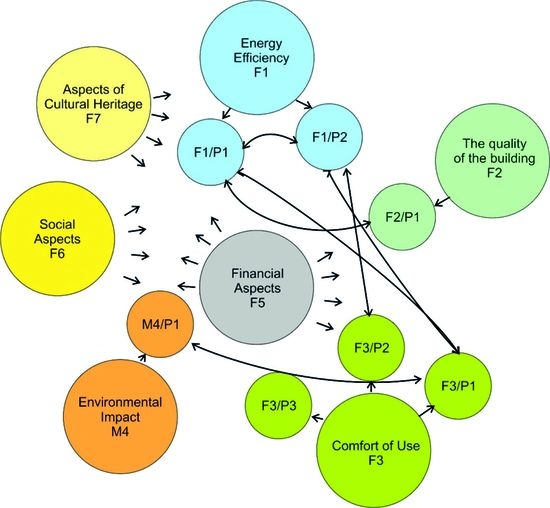Evaluation of the Criteria for Selecting Proposed Variants of Utility Functions in the Adaptation of Historic Regional Architecture
Abstract
1. Introduction
2. Representative Building and Methods of Analysis
- Public building—Hostel (existing condition (‘Reference variant’);
- Public building—Five-star hotel (‘Variant 1’);
- Public building—Zakopane Art Gallery (‘Variant 2’); and
- Public building—Conference and training centre with accommodation option (‘Variant 3’)
3. Evaluation of Criteria for the Existing State and Variants of New Functions
3.1. Criterion F1/P1-Energy Efficiency; Improvement of Insulation of External Partitions
3.1.1. Methods
3.1.2. Results
3.2. Criterion F1/P2-Energy Efficiency; Improvement of the Final Energy Index EK (kWh/(m2year))
3.2.1. Methods
- Qk—annual demand for final energy supplied to a building or part of a building for technical systems (kWh/year); and
- Af—area of rooms with adjustable air temperature (heated or cooled surface) (m2).
3.2.2. Results
3.3. Criterion F2/P1-Quality of the Building Envelope; Improving the Tightness of the Building Envelope; Detection of Thermal Bridges through Thermography Tests
3.3.1. Methods
3.3.2. Results
3.4. Criterion F3/P1-Comfort of Using the Rooms; Thermal Comfort
3.4.1. Methods
- ta—air temperature measurement;
- tg—temperature of blackened sphere (heat radiation meter)—the black sphere, in agreement with the norms, should be 15 cm in diameter;
- tnw—natural wet-bulb temperature measurement;
- RH—measurement of relative air humidity; and
- Va—measurement of air flow speed.
| PMV | = [0.303 × exp(−0.306 × M) + 0.028] × ((M − W) − 3.05 × 10−3 × [x5733 − 6.99 × (M − W) − pa] |
| −0.42 × [(M − W) − 58.15] − 1.7 × 10−5 × M × (5867 − pa) − 0.0014 × M × (34 − ta) | |
| −3.96 × 10−8 × fcl × [(tcl + 273)4-(t−r + 273)4] − fcl × hc × (tcl − ta)) | |
| tcl = 35.7 − 0.028 × (M − W) − Icl{3.96 × 10−8 × fcl × [(tcl + 273)4 − (t−r + 273)4] + fcl × hc × (tcl − ta)} |
- M—the amount of metabolism (W/m2);
- W—the density of energy loss in the form of mechanical work (W/m2);
- Icl—clothing insulation ( m2K/W);
- fcl—surface of clothes (m2);
- ta—air temperature (°C);
- t−r—average radiation temperature (°C); and
- tcl—temperature of the clothes surface (°C).
3.4.2. Results
3.5. Criterion F3/P2-Comfort of Using the Rooms; Vibration Comfort
3.5.1. Methods
3.5.2. Results of Human Perception of Vibrations
3.6. Criterion F3/P4-Comfort of Using the Rooms; Acoustic Comfort
3.6.1. Methodology
3.6.2. Requirements for the Internal Noise Level
- T—reverberation time in unfurnished room (s); and
- T0—reference value of reverberation time (s).
3.6.3. Results of Measurement
- -
- The main problem of this hotel building is the tightness of windows resulting in low airborne sound insulation.
- -
- Installation of proper windows with a sufficiently high parameter of airborne sound insulation;
- -
- The possibility to increase the percentage of rooms meeting the requirements if proper seals in existing windows are provided; and
- -
- modernisation of the building to take into account the acoustic climate in the building and solve the problem especially relating to noise traffic in bedrooms.
3.7. Criterion F4/P1-Impact on the Environment; Coefficient EP (kWh/(m2y))
3.7.1. Methods
3.7.2. Results
3.8. Financial Criterion F5P1
3.8.1. Assessment Method
3.8.2. Results
3.9. Criteria F6-Social Benefits and F7 Benefits from Preserving Cultural Heritage
3.9.1. Assessment Method
3.9.2. Results
4. Conclusions and Discussion
Author Contributions
Funding
Conflicts of Interest
Nomenclature
| U | (W/(m2K))—Heat transfer coefficient |
| EK | (kWh/(m2year))—The final energy value |
| n50 | Number of air changes per hour, as a result of the leak test of the building envelope |
| clo | Clothing unit, 1 clo = 0.155 (m2·K/W) |
| Icl | Clothing insulation (m2 K/W) |
| MET | Metabolic rate (W/m2), 1 unit = 1 met = 58.2 W/m |
| PMV | Predicted mean vote—Thermal Sensation Index (ISO 7730) |
| PPD | Percentage of persons dissatisfied (percentage dissatisfied) |
| RH | Relative humidity (%) |
| Ta | Measured air temperature (°C) |
| TMR | Mean radiant temperature (°C) |
References
- Terlikowski, W. The role of rehabilitation, modernization and adaptation of historic buildings in the revitalization process. J. Civ. Eng. Environ. Arch. 2015, 62, 519–832. [Google Scholar]
- Nowogońska, B. The Life Cycle of a Building as a Technical Object. Periodica Polytech. Civ. Eng. 2016, 60, 331–335. [Google Scholar] [CrossRef]
- Nowogońska, B. Proposal for determining the scale of renovation needs of residential buildings. Civ. Environ. Eng. Rep. 2016, 22, 137–144. [Google Scholar] [CrossRef][Green Version]
- Collective Work, Antique Wooden Construction in Poland; Szczecin University of Technology: Szczecin, Poland, 2008; Volume 5.1, ISBN 978-83-7457-052-7.
- Dz, U. 1994 Nr 89 poz. 414 The Act of 7 July 1994 Construction Law. Available online: http://prawo.sejm.gov.pl/isap.nsf/DocDetails.xsp?id=wdu19940890414 (accessed on 6 February 2019).
- Dz, U. 2003 nr 162 poz. 1568 The Act of 23 July 2003 on the Protection of Monuments. Available online: http://prawo.sejm.gov.pl/isap.nsf/DocDetails.xsp?id=WDU20031621568 (accessed on 6 February 2019).
- Regulation of the Minister of Infrastructure on the Technical Conditions to Be Met by Buildings and Their Location (Journal of Laws No. 75, Item 690), Including Changes Introduced. Available online: http://prawo.sejm.gov.pl/isap.nsf/download.xsp/WDU20150001422/O/D20151422.pdf (accessed on 6 February 2019).
- Radziszewska-Zielina, E.; Śladowski, G. Fuzzy inference system assisting the choice of a variant of adaptation of a historical building. Inter. J. Contemp. Manag. 2015, 14, 131–148. [Google Scholar]
- Radziszewska-Zielina, E.; Śladowski, G.; Sibielak, M. Planning the reconstruction of a historic building by using a fuzzy stochastic network. Autom. Constr. 2017, 84, 242–257. [Google Scholar] [CrossRef]
- Radziszewska-Zielina, E.; Śladowski, G. Proposal of the Use of a Fuzzy Stochastic Network for the Preliminary Evaluation of the Feasibility of the Process of the Adaptation of a Historical Building to a Particular Form of Use OP Conference Series. Mater. Sci. Eng. 2017, 245, 072029. [Google Scholar] [CrossRef]
- Ustinovicius, L.; Jakucionis, S. Application of multicriteria decision methods in restoration of buildings in the old Town. J. Civ. Eng. Manag. 2000, 6, 227–236. [Google Scholar] [CrossRef][Green Version]
- Zavadskas, E.; Anucheviciene, J. Development of an Indicator Model and Ranking of Sustainable Revitalization Alternatives of Derelict Property: A Lithuanian Case Study. Sustain. Dev. 2006, 14, 287–299. [Google Scholar] [CrossRef]
- Zavadskas, E.; Anucheviciene, J. Multiple criteria evaluation of rural building’s regeneration alternatives. Build. Environ. 2007, 42, 436–451. [Google Scholar] [CrossRef]
- Fuentes, J.M. Methodological bases for documenting and reusing vernacularfarm architecture. J. Cult. Herit. 2010, 11, 119–129. [Google Scholar] [CrossRef]
- Wang, H.; Zeng, Z. A Multi-objective decision-making process for reuse selection of historic buildings. Exp. Syst. Appl. 2010, 37, 1241–1249. [Google Scholar] [CrossRef]
- Breil, M.; Giove, S.; Rosato, P. A Multicriteria Approach for the Evaluation of the Sustainability of Re-Use of Historic Buildings in Venice; SSRN: Milan, Italy, 2008. [Google Scholar]
- Giove, S.; Rosato, P.; Breil, M. An application of multicriteria decision making to built heritage. The redevelopment of Venice Arsenale. J. Multi Criteria Dec. Anal. 2010, 17, 85–99. [Google Scholar] [CrossRef]
- Ferretti, V.; Bottero, M.; Mondini, G. Decision making and cultural heritage: An application of the Multi-Attribute Value Theory for the reuse of historical buildings. J. Cult. Herit. 2014, 15, 644–655. [Google Scholar] [CrossRef]
- Radziszewska-Zielina, E.; Śladowski, G. Supporting the selection of a variant of the adaptation of a historical building with the use of fuzzy modelling and structural analysis. J. Cult. Herit. 2017, 26, 53–63. [Google Scholar] [CrossRef]
- Fedorczak-Cisak, M.; Kowalska, A.; Radziszewska-Zielina, E.; Śladowski, G.; Pachla, F.; Tatara, T. A multicriteria approach for selecting the utility function of the historical building “Stara Polana” located in Zakopane. MATEC Web Conf. 2019, 262, 07002. [Google Scholar] [CrossRef]
- PN-EN ISO 6946: 2017-10. Building Components and Building Elements—Thermal Resistance and Heat Transfer Coefficient—Calculation Method; Polish Standardization Committee: Warsaw, Poland, 2017.
- PN-EN ISO 13370: 2017-09. Thermal Performance of Buildings—Heat Transfer via the Ground—Calculation Methods; Polish Standardization Committee: Warsaw, Poland, 2017.
- Regulation of the Minister of Infrastructure and Development of 27 February 2015 on the Methodology of Determining the Energy Performance of a Building or Part of a Building and Energy Performance Certificates. Available online: http://prawo.sejm.gov.pl/isap.nsf/DocDetails.xsp?id=WDU20150000376 (accessed on 6 February 2019).
- PN-EN ISO 9972: 2015-10. Thermal Properties of Buildings—Determination of Air Permeability Of Buildings—Pressure Measurement Method with the Use of a Fan; Polish Standardization Committee: Warsaw, Poland, 2015.
- PN-EN 13187: 2001. Thermal Properties of Buildings—Qualitative Detection of Thermal Defects in the Building Envelope—Infrared Method; Polish Standardization Committee: Warsaw, Poland, 2001.
- Fanger, P.O. Assessment of man’s thermal comfort in practice. Occup. Environ. Med. 1973, 30, 313–324. [Google Scholar] [CrossRef]
- PN-EN ISO 7730: 2006. Ergonomics of The thermal Environment—Analytical Determination and Interpretation of Thermal Comfort Using the Calculation of PMV and PPD Indicators and Criteria of Local Thermal Comfort; Polish Standardization Committee: Warsaw, Poland, 2006.
- Draft EN 16798-1. Energy Performance of Buildings—Ventilation of Buildings—Part 1: Indoor Environmental Input Parameters for Design and Assessment of Energy Performance of Buildings Addressing Indoor Air Quality, Thermal Environment, Lighting and Acoustics (Module M1–6. 2018); European Committee for Standardization: Brussels, Belgium, 2018. [Google Scholar]
- EN 15251: 2007. Indoor Environmental Input Parameters for Design and Assessment of Energy Performance of Buildings Addressing Indoor Air Quality, Thermal Environment, Lighting and Acoustics; European Committee for Standardization: Brussels, Belgium, 2017. [Google Scholar]
- PN ISO 7726: 2001. Ergonomics of the Thermal Environment. Instruments for Measuring Physical Quantities; Polish Standardization Committee: Warsaw, Poland, 2001.
- PN-B-02171: 2017-06. Evaluation of Human Exposure to Vibration in Buildings; Polish Standardization Committee: Warsaw, Poland, 2017.
- PN-B-02151-2: 2018-01. Building Acoustics—Noise Protection in Buildings—Part 2: Requirements for Acceptable Sound Level in Rooms; Polish Standardization Committee: Warsaw, Poland, 2018.
- Dudzik, M.; Trębacz, P.; Hudym, V. Modeling of contact wire’s de-iceing phenomena using artificial neural networks. Tech. Trans. 2018, 115, 111118. [Google Scholar] [CrossRef]
- Dudzik, M. Współczesne Metody Projektowania, Weryfikacji Poprawności i Modelowania Zjawisk Trakcji Elektrycznej; Monografie Politechniki Krakowskiej. Inżynieria Elektryczna i Komputerowa; Monografia, Politechnika Krakowska im. Tadeusza Kościuszki: Kraków, Poland, 2018; p. 187s. ISBN 978-83-65991-28-7. [Google Scholar]
- Energieeinsparverordnung—EnEV (Verordnung Über Energiesparenden Wärmeschutz und Energiesparende Anlagentechnik bei Gebäuden). Available online: www.enev-online.com (accessed on 6 February 2019).
- NEEAP. Erster Nationaler Energieeffizienzaktionsplan der Republik Österreich 2014 Gemäß Energieeffizienzrichtlinie 2012/27/EU; Bundesministerium für Bildung: Wissenschaft und Forschung Vienna, Austria, 2014.
- Kisilewicz, T. The influence of thermal insulation of walls on the microclimate in buildings in the summer. Build. Mater. 2015, 5. [Google Scholar] [CrossRef]
- Firląg, S.; Piasecki, M. NZEB Renovation Definition in a Heating Dominated Climate. Case Study of Poland. Appl. Sci. Basel 2018, 8, 1605. [Google Scholar] [CrossRef]
- Piasecki, M.; Kostyrko, K.; Pykacz, S. Indoor environmental quality assessment: Part 1: Choice of the indoor environmental quality sub-component models. J. Build. Phys. 2017, 41, 264–289. [Google Scholar] [CrossRef]
- PN-EN ISO 9920:2009. Ergonomics of the Thermal Environment—Estimation of Thermal Insulation and Water Vapor Resistance of Clothing Sets; Polish Standardization Committee: Warsaw, Poland, 2009.
- Sun, K.; Zhang, W. Combined Annoyance Assessment of Subway Train-Induced Structural Vibration and Ambient Noise. Shock Vib. 2016, 2016, 3028037. [Google Scholar] [CrossRef]
- Ögren, M.; Gidlöf-Gunnarsson, A.; Smith, M.; Gustavsson, S.; Persson Waye, K. Comparison of Annoyance from Railway Noise and Railway Vibration. Int. J. Environ. Res. Public Health 2017, 14, 805. [Google Scholar] [CrossRef] [PubMed]
- Gierke, M.E.; Coerman, R.R. The biodynamics of human response to vibration and impact. Ind. Med. Surg. 1963, 32, 30–32. [Google Scholar]
- Dudzik, M.; Tomczyk, K.; Sieja, M. Optimal dynamic error formula for charge output accelerometer obtained by the neural network. In Proceedings of the 2018 International Symposium on Electrical Machines (SME): SME 2018, Andrychów, Poland, 10–13 June 2018; ISBN 978-153865210-7. [Google Scholar] [CrossRef]
- Dudzik, M.; Tomczyk, K.; Jagiełło, A.S. Analysis of the error generated by the voltage output accelerometer using the optimal structure of an artificial neural network. In Proceedings of the 2018 19th International Conference on Research and Education in Mechatronics (REM 2018), Delft, The Netherlands, 7–8 June 2018; pp. 7–11, ISBN 978-1-5386-5413-2. [Google Scholar] [CrossRef]
- Marioka, M.; Griffin, M.J. Difference thresholds for intensity perception of whole-body vertical vibration: Effect of frequency and magnitude. J. Acoust. Soc. Am. 2000, 107, 620–624. [Google Scholar] [CrossRef]
- ISO 2631-2: 2003. Guide to the Evaluation of Human Exposure to Whole Body Vibration. Part 2—Vibration in Buildings; International Organization for Standardization: Geneva, Switzerland, 2003. [Google Scholar]
- Kowalska-Koczwara, A.; Pachla, F.; Stecz, P.; Stypuła, K.; Tatara, T.; Lejk, J.; Sokołowski, M. Vibration-based damage identification and condition monitoring of metro trains: Warsaw Metro case study. Shock Vib. 2018, 2018, 8475684. [Google Scholar] [CrossRef]
- Tamura, Y.; Kawana, S.; Nakamura, O.; Kanda, J.; Nakatà, S. Evaluation perception of wind-induced vibration in buildings. Struct. Build. 2006, 159, 283–293. [Google Scholar] [CrossRef]
- Kwok, K.C.S.; Hitchcock, P.A.; Burton, M.D. Perception of vibration and occupant comfort in wind-excited tall buildings. J. Wind Eng. Ind. Aerodyn. 2009, 97, 368–380. [Google Scholar] [CrossRef]
- Waddington, D.C.; Woodcock, J.; Peris, E.; Condie, J.; Sica, G.; Moorhouse, A.T.; Steele, A. Human response to vibration in residential environments. J. Acoust. Soc. Am. 2014, 135, 182–193. [Google Scholar] [CrossRef] [PubMed]
- Okokon, E.O.; Yli-Tuom, T.; Tiittanen, A.W.; Tiittanen, P.; Juutilainen, J.; Lanki, T. Traffic noise, noise annoyance and psychotropic medication use. Environ. Int. 2018, 119, 287–294. [Google Scholar] [CrossRef]
- Beranek, L.L. Acoustic Measurements; American Institute of Physics: New York, NY, USA, 1949; ISBN 088-318590-3. [Google Scholar]
- Bruel & Kjaer. Environmental Noise Measurement; Bruel & Kjaer: Nærum, Denmark, 2001. [Google Scholar]
- Makarewicz, R.; Gołębiewski, R. Estimation of the long term average sound level from hourly average. Appl. Acoust. 2016, 111, 116–120. [Google Scholar] [CrossRef]
- Malchaire, J. Sound Measuring Instruments; WHO: Brussels, Belgium, 1994. [Google Scholar]
- Costa, J.J.L.; Nascimento, E.O.D.; Oliveira, L.N.D.; Caldas, L.V.E. Pressure sound level measurements at an educational environment in Goiânia, Goiás, Brazil. J. Phys. Conf. Ser. 2017, 975, 012055. [Google Scholar] [CrossRef]
- Park, T.; Kim, M.; Jang, C.; Choung, T.; Sim, K.-A.; Seo, D.; Chang, S.I. The Public Health Impact of Road-Traffic Noise in a Highly-Populated City, Republic of Korea: Annoyance and Sleep Disturbance. Sustainability 2018, 10, 2947. [Google Scholar] [CrossRef]
- Sirin, O. State-of-the-Art Review on Sustainable Design and Construction of Quieter Pavements—Part 2: Factors Affecting Tire-Pavement Noise and Prediction Models. Sustainability 2016, 8, 692. [Google Scholar] [CrossRef]
- Aasvang, G.M.; Engdahl, B.; Rothschild, K. Annoyance and self-reported sleep disturbances due to structurally radiated noise from railway tunnels. Appl. Acoust. 2007, 68, 970–981. [Google Scholar] [CrossRef]
- Frei, P.; Mohler, E.; Roosli, M. Effect of nocturnal road traffic noise exposure and annoyance on objective and subjective sleep quality. Int. J. Hyg. Environ. Health 2014, 217, 188–195. [Google Scholar] [CrossRef] [PubMed]
- Bogucki, D. Feasibility Study—Guide; PRESSCOM Sp. z o.o.: Wrocław, Poland, 2016. [Google Scholar]
- Affelt, W. Technical Heritage as a Part of Culture, Towards a Sustainable Heritage (Part 2), Protection of Monuments; National Heritage Board of Poland: Warsaw, Poland, 2009; pp. 53–82. [Google Scholar]
- Radziszewska-Zielina, E.; Śladowski, G. Evaluation of historic building conversion options in the context of sustainable development. Tech. Trans. 2014, 1B, 153–164. [Google Scholar] [CrossRef]
- Roberts, F.S. Applications of the theory of meaningfulness to psychology. J. Math. Psychol. 1985, 29, 311–332. [Google Scholar] [CrossRef]
- Saaty, T.L. Decision Making with Dependence and Feedback: The Analytic Network Process; University of Pittsburgh: Pittsburgh, PA, USA; RWS Publications: Pittsburgh, PA, USA, 1996; ISBN 0-9620317-9-8. [Google Scholar]
- Gabus, A.; Fontela, E. World Problems an Invitation to Further Thought within the Framework of DEMATEL; Battelle Geneva Research Centre: Geneva, Switzerland, 1972. [Google Scholar]
- Michnik, J. Weighted Influence Non-linear Gauge System (WINGS)—An analysis method for the systems of interrelated components. Eur. J. Oper. Res. 2013, 228, 536–544. [Google Scholar] [CrossRef]
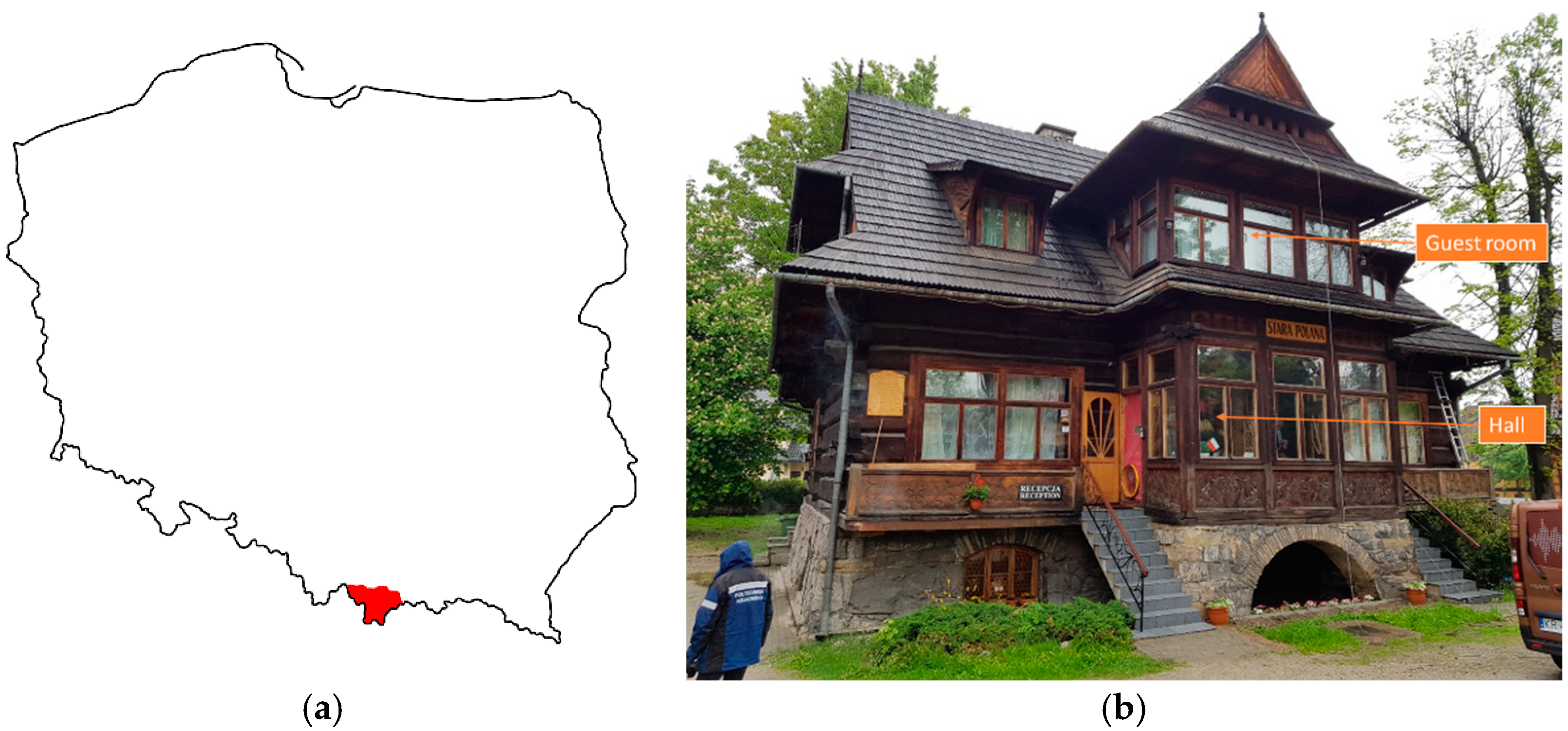
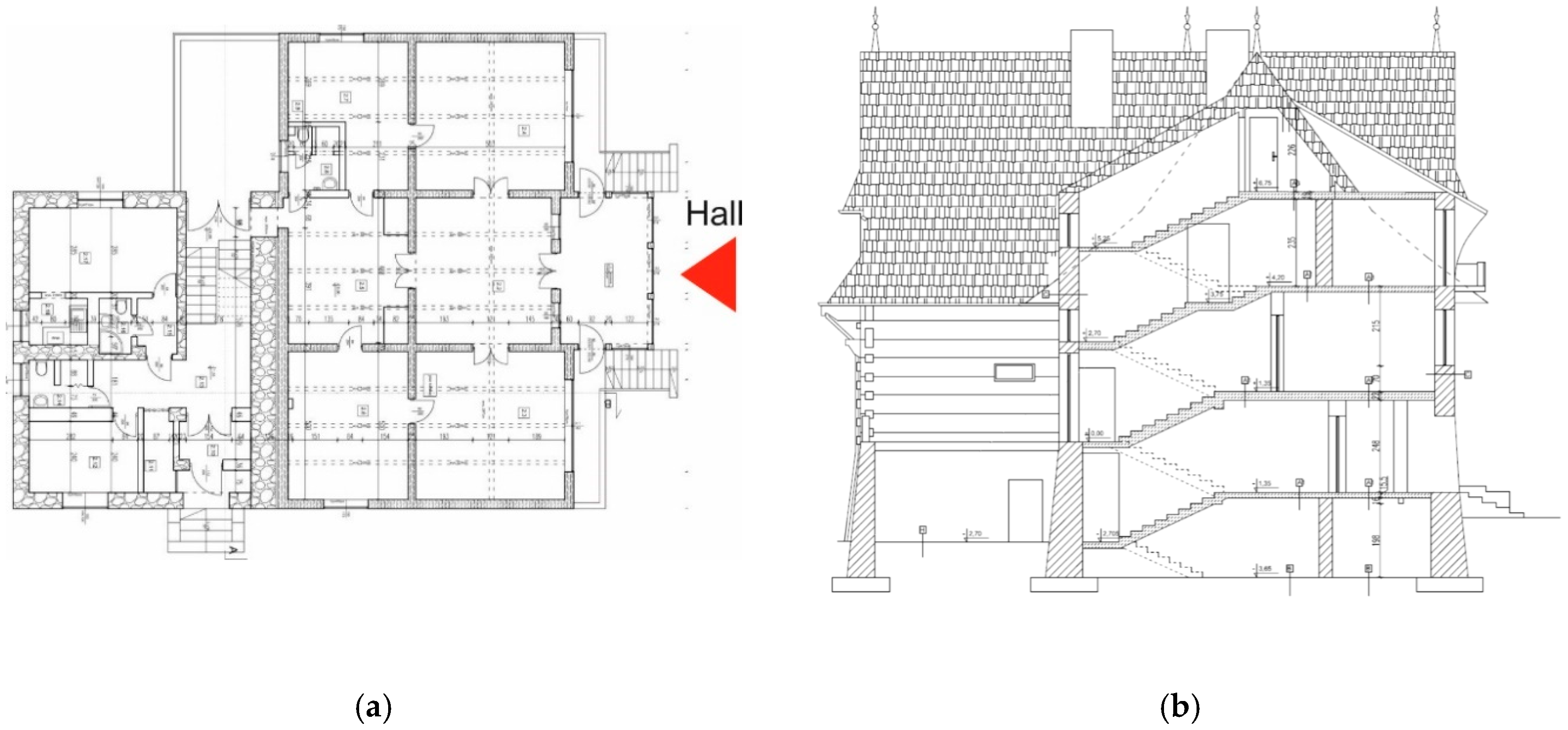
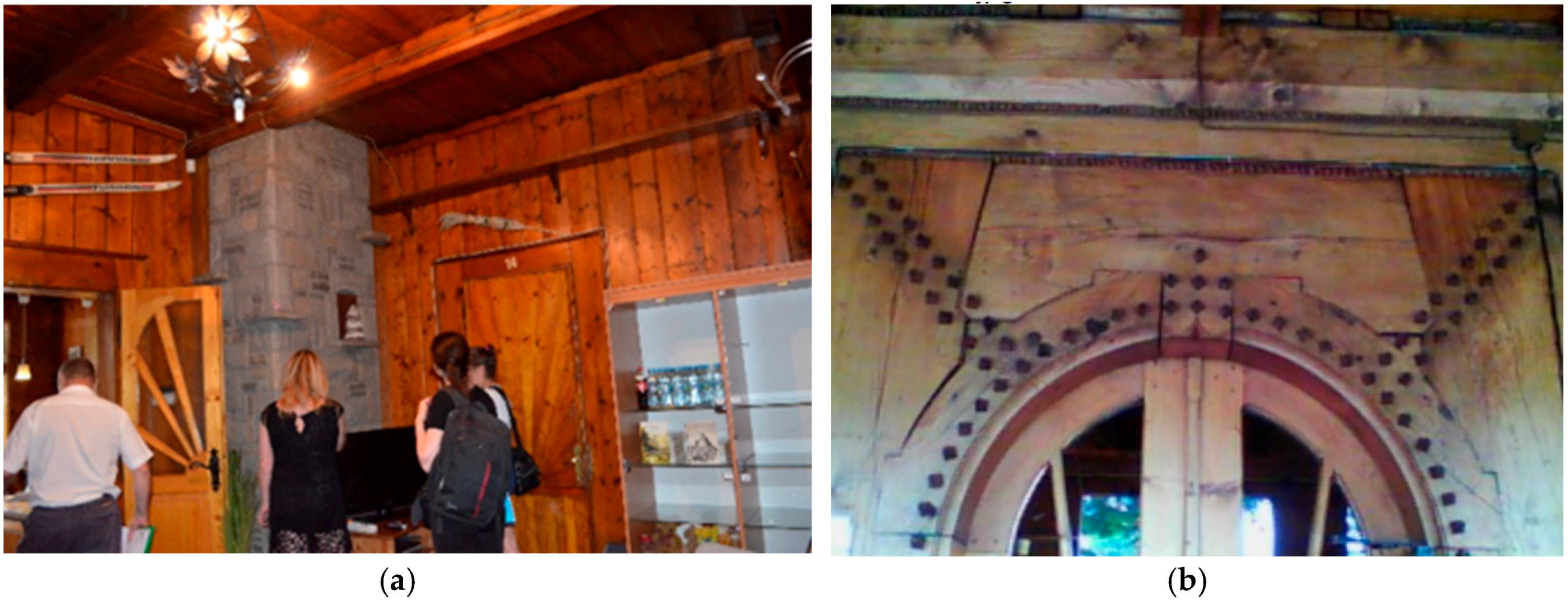
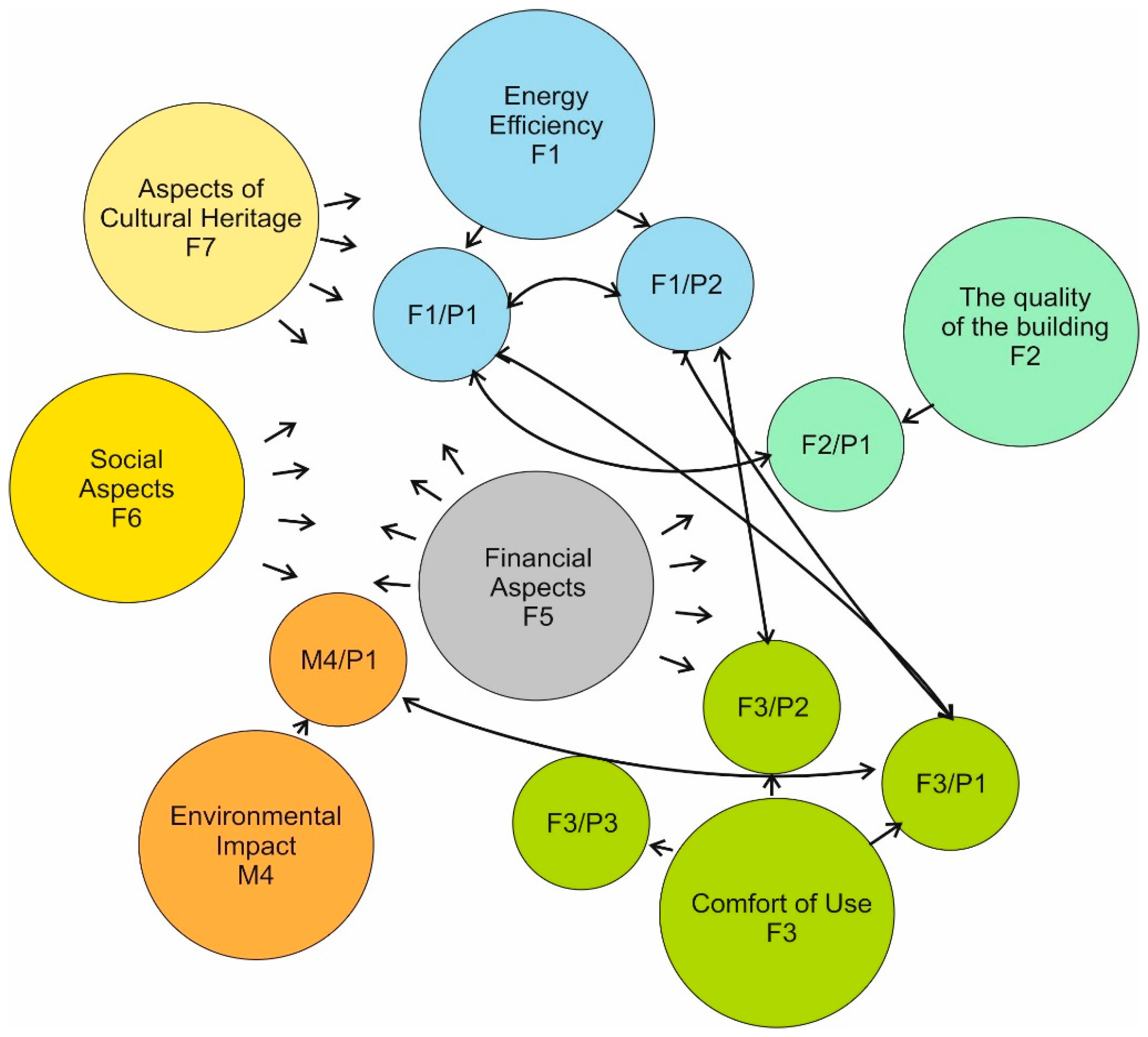
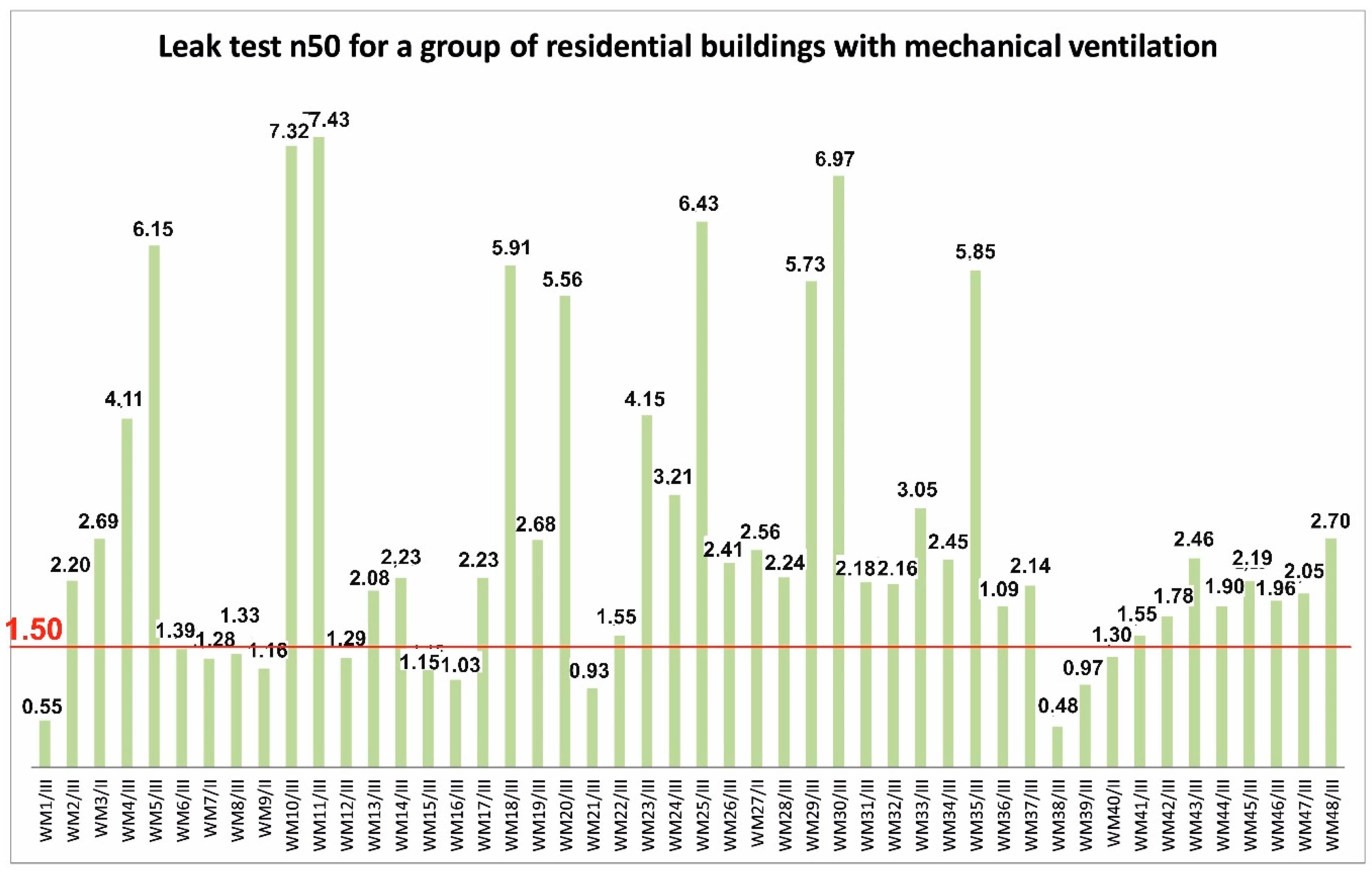
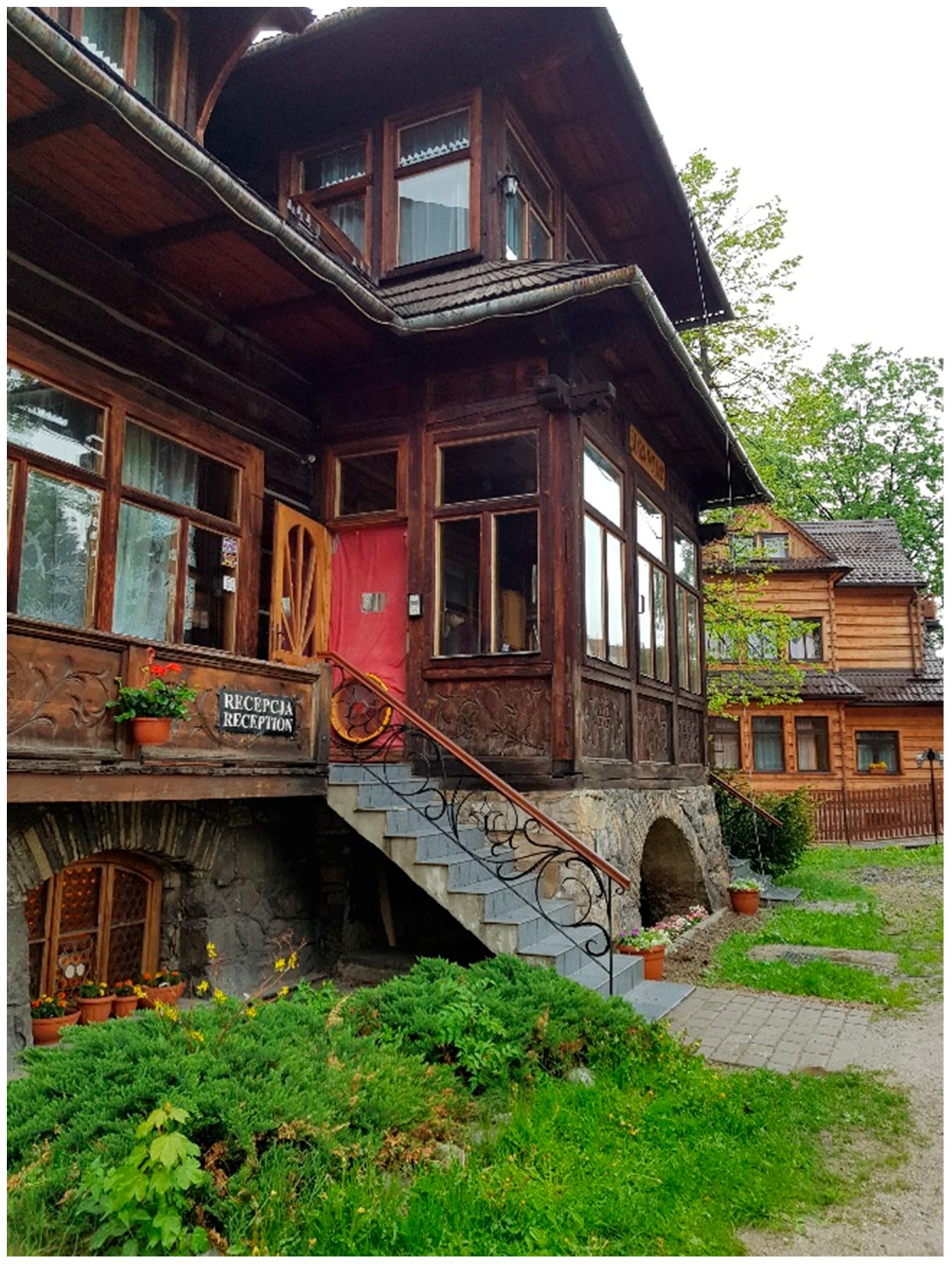
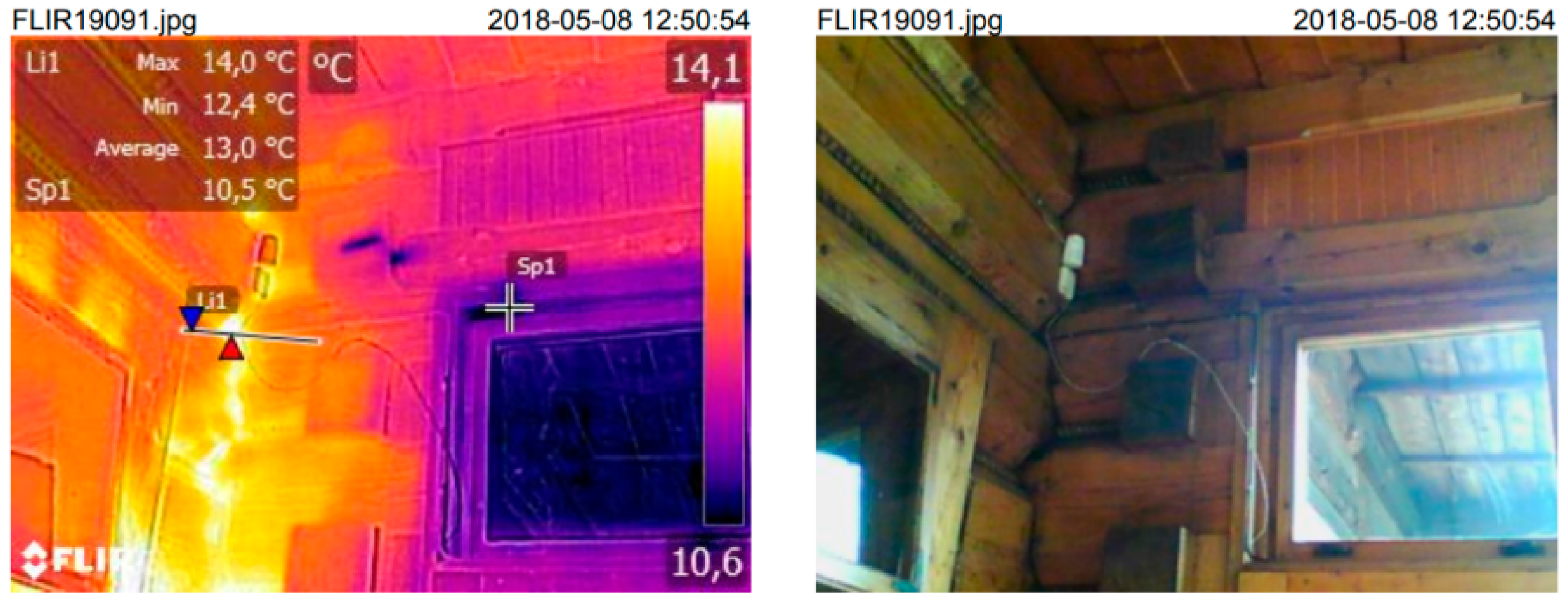
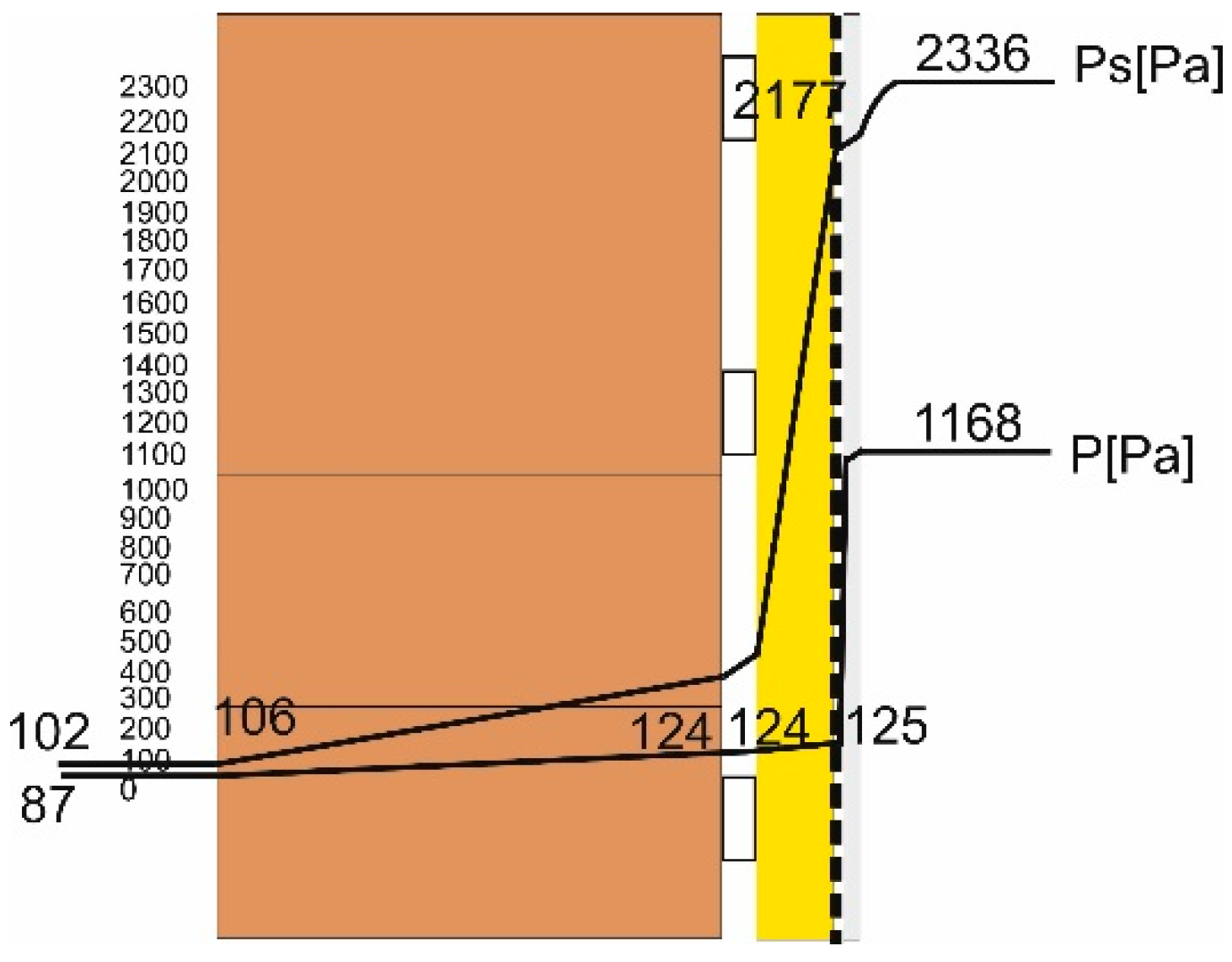
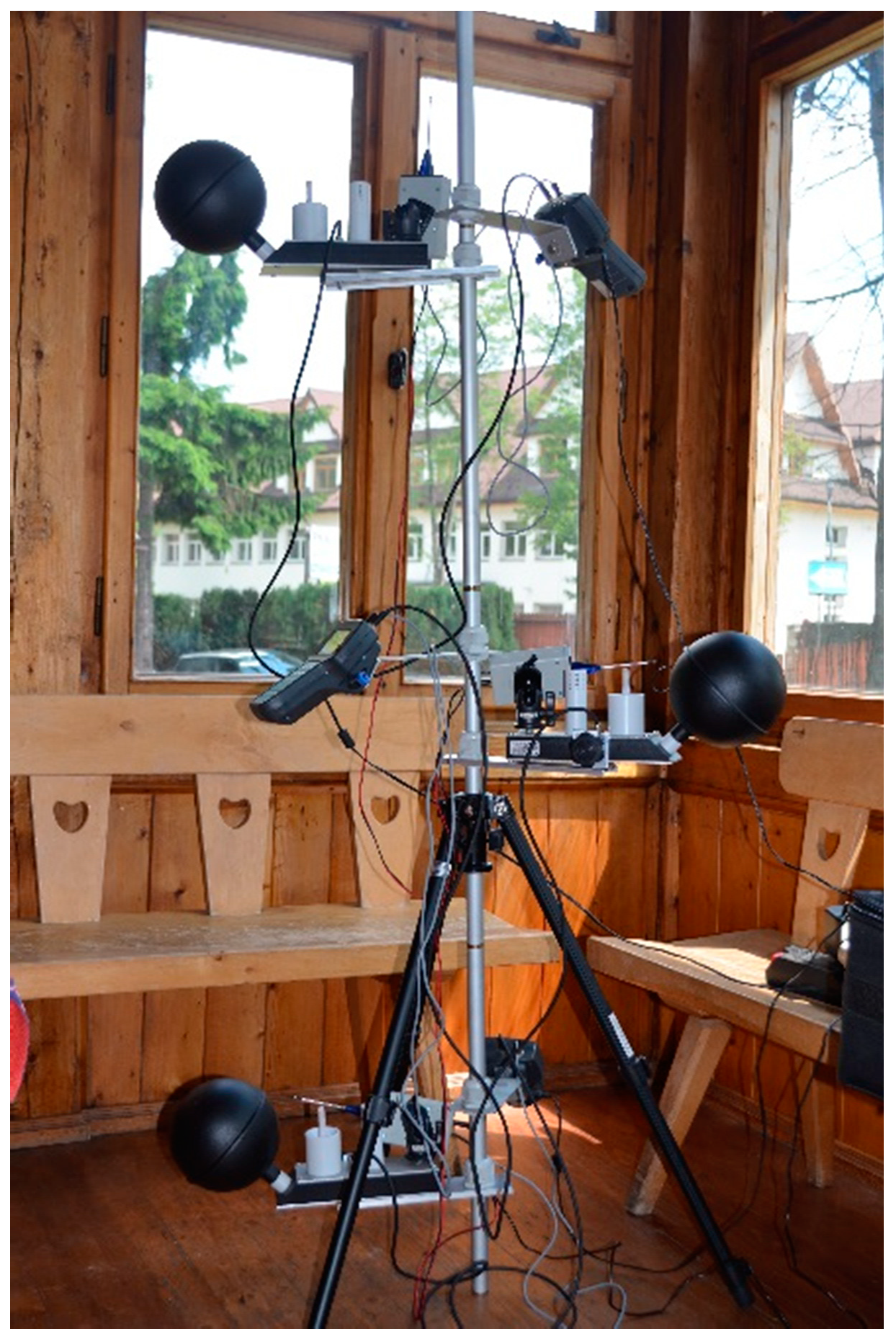
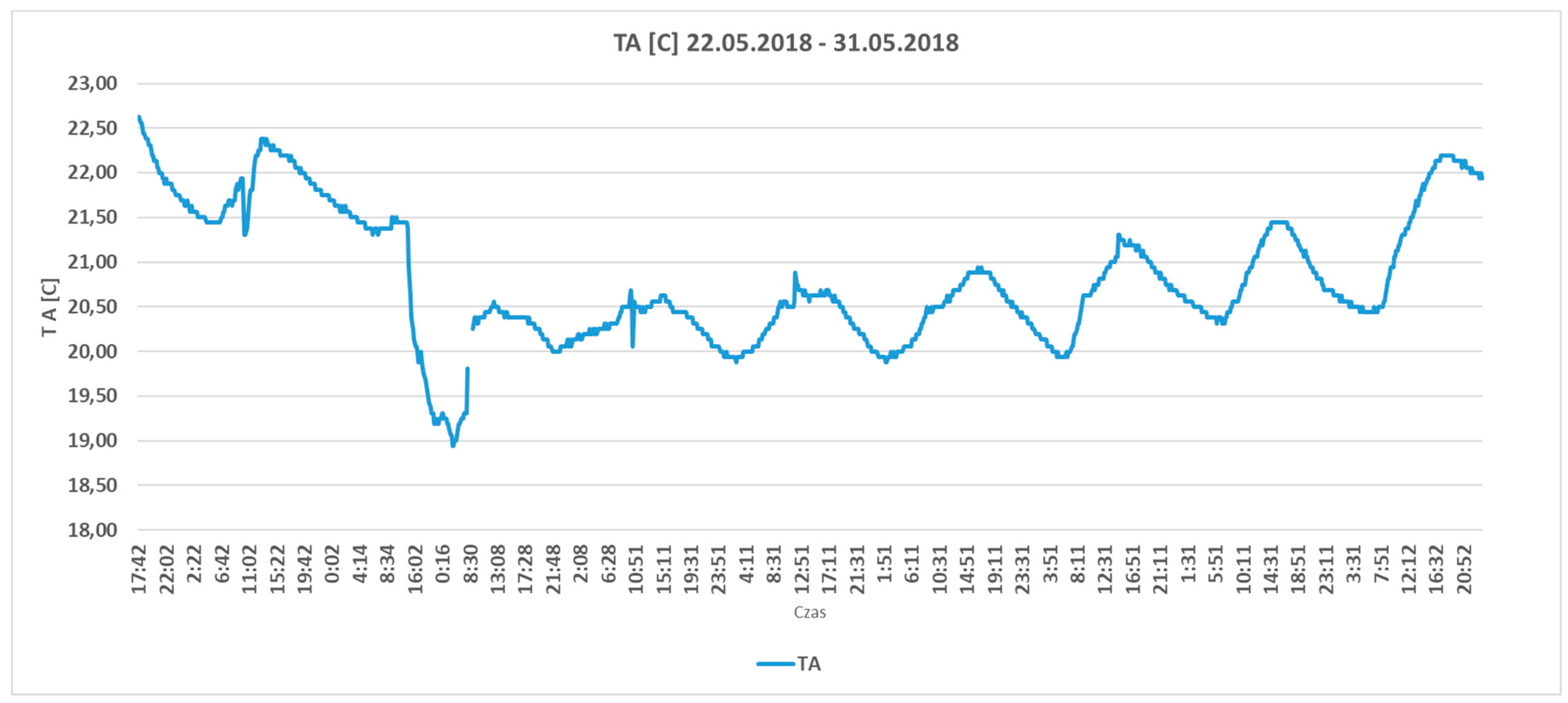
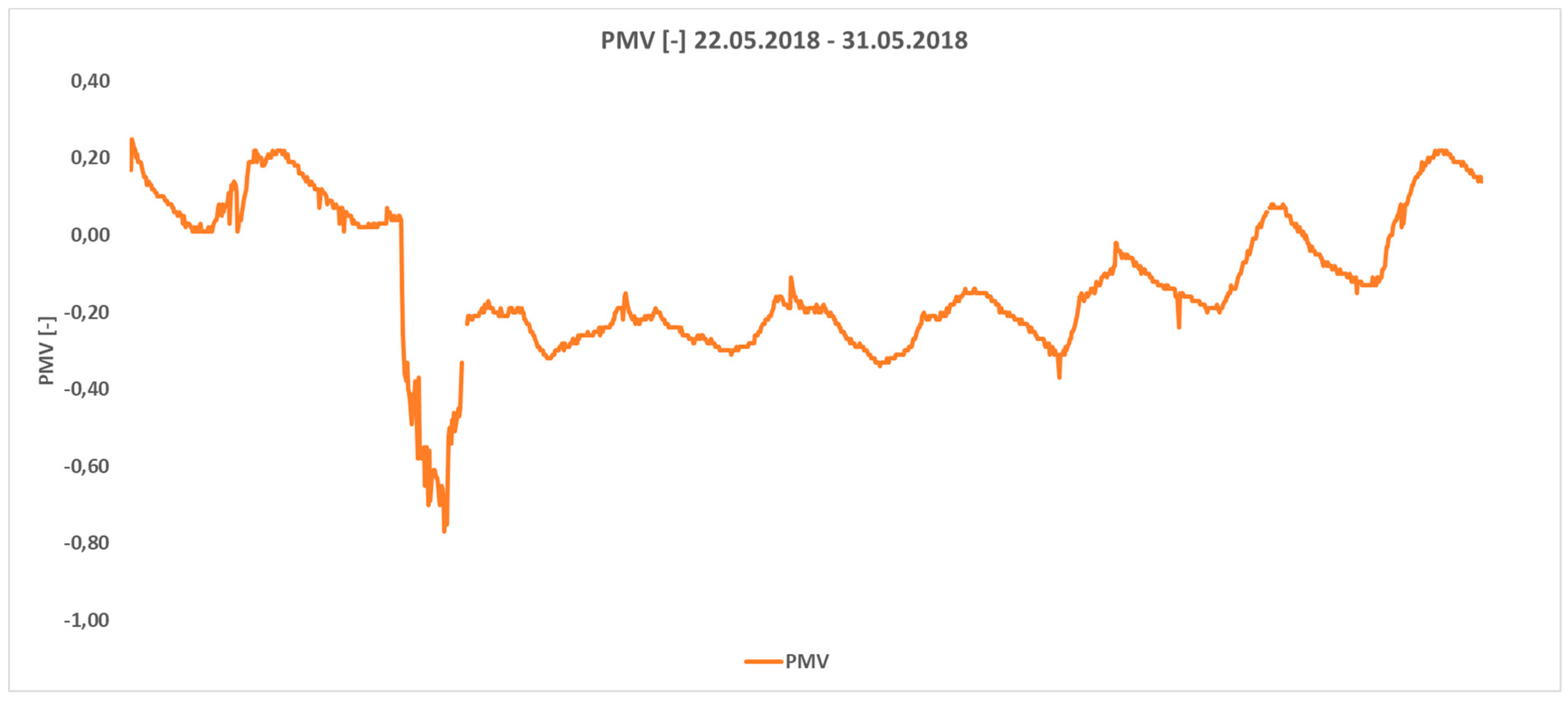
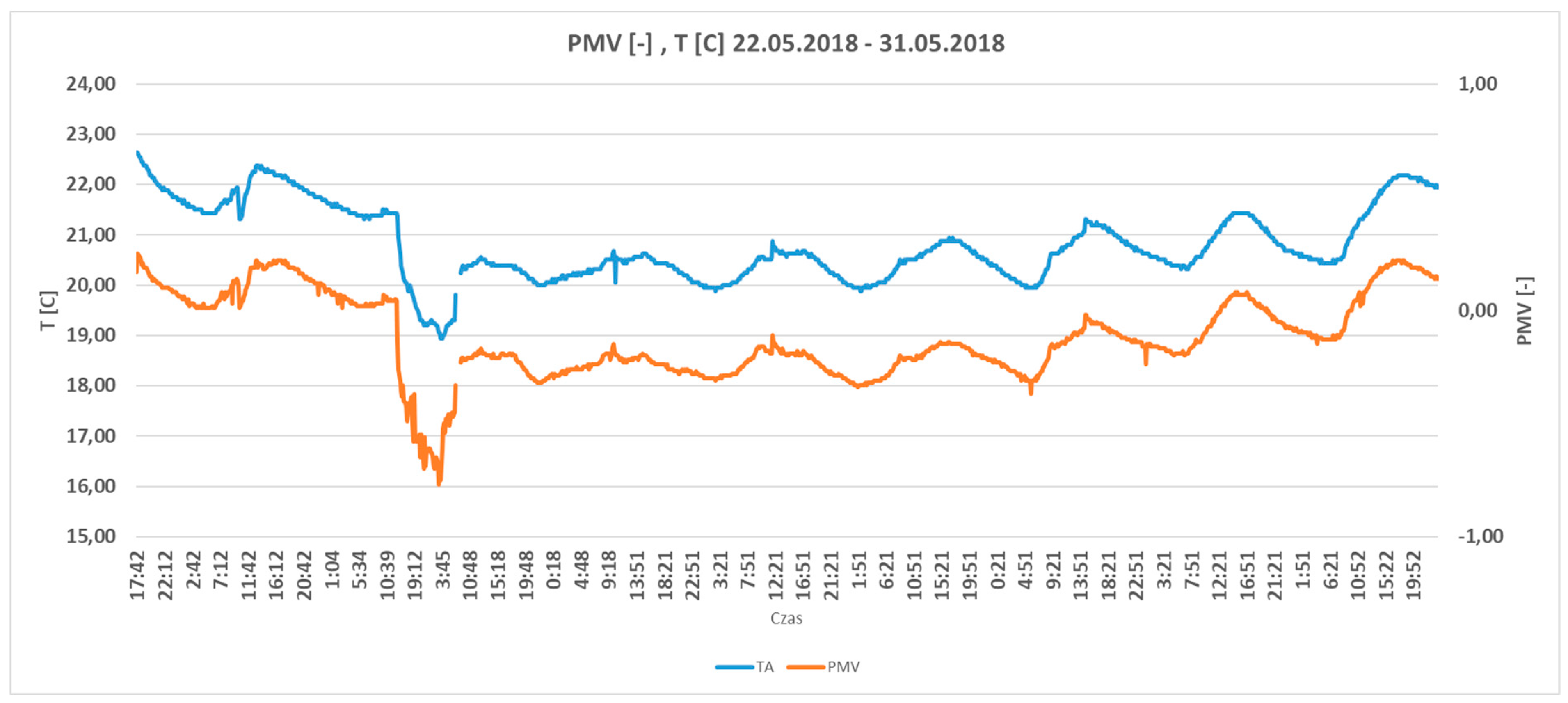
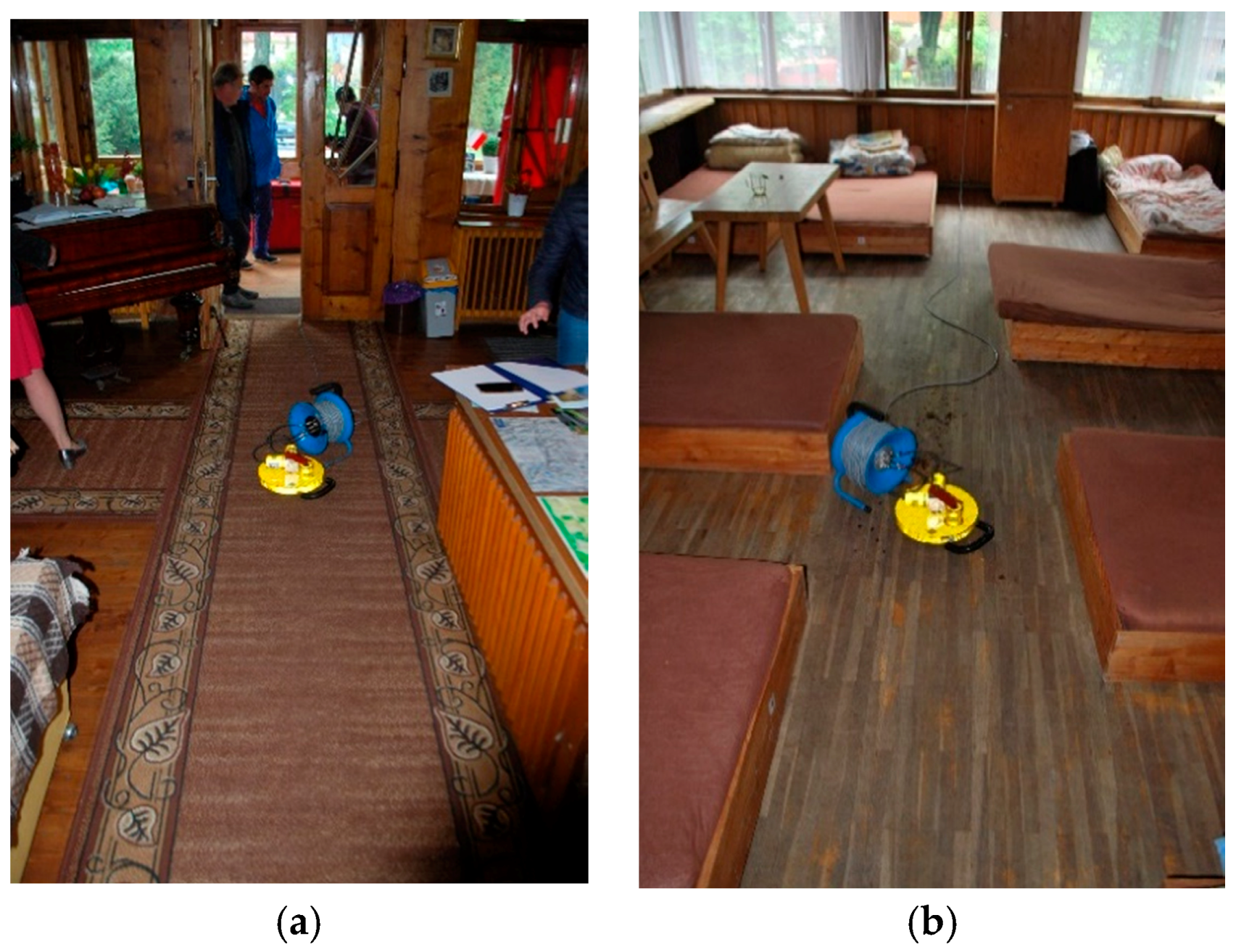
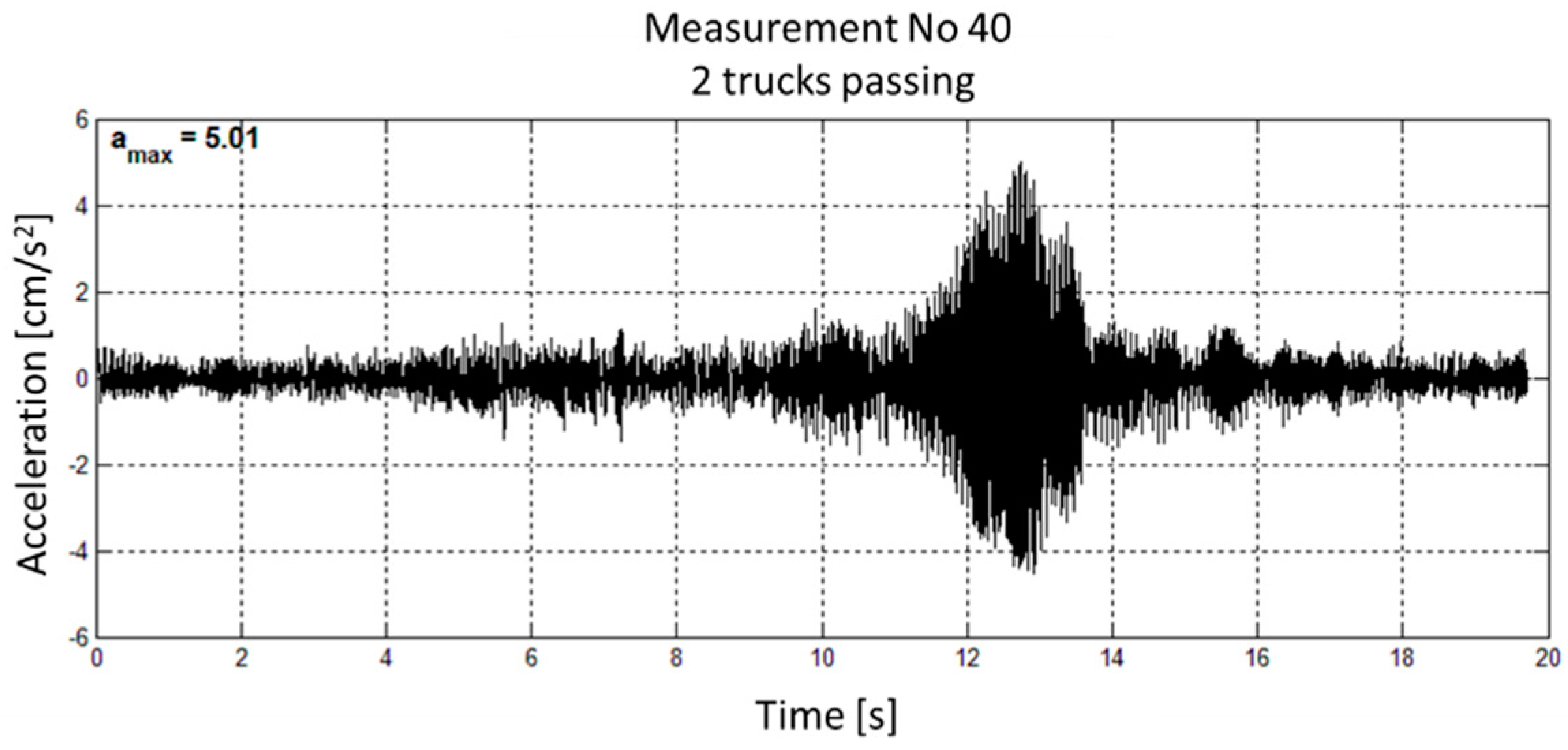
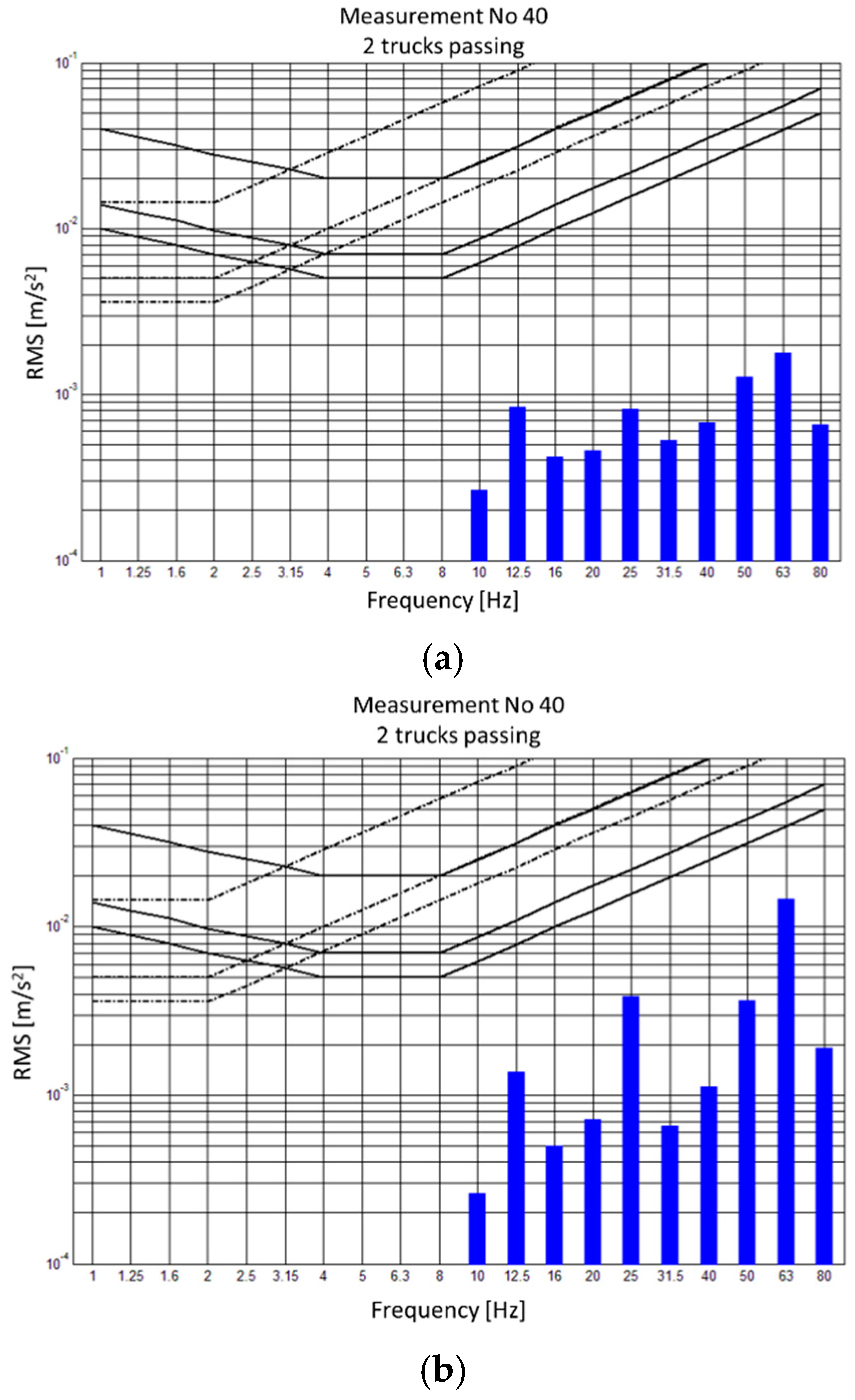
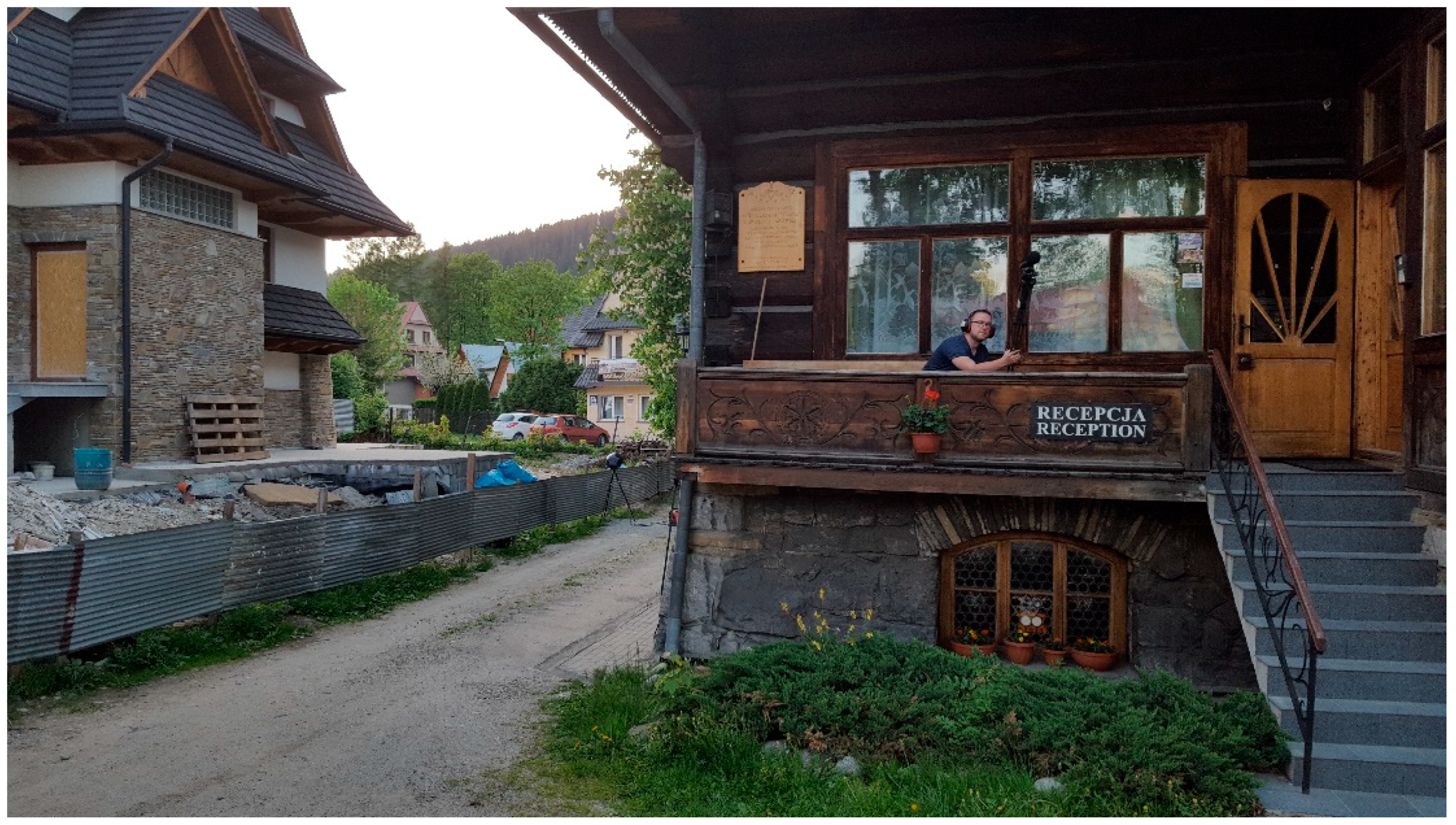
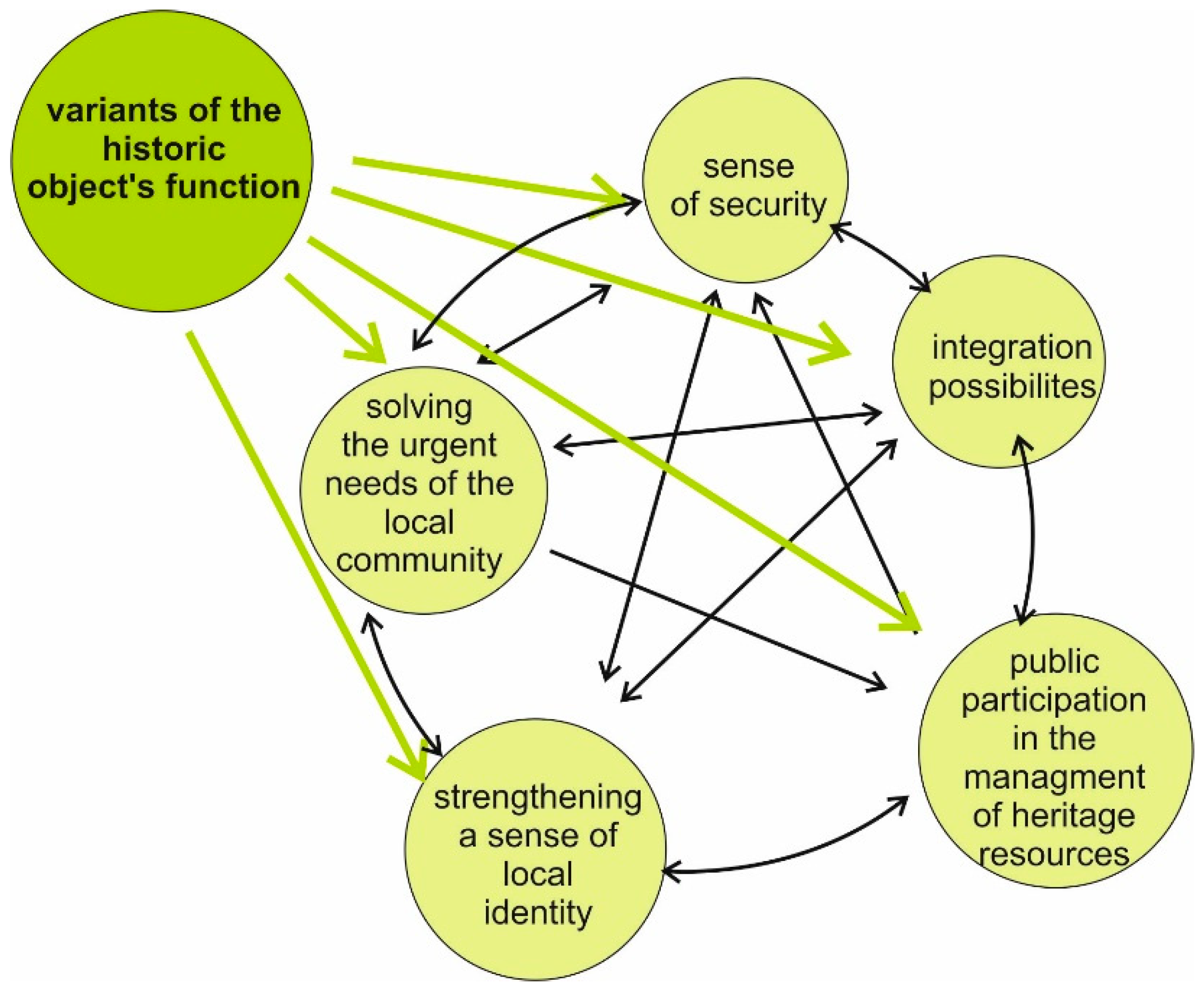
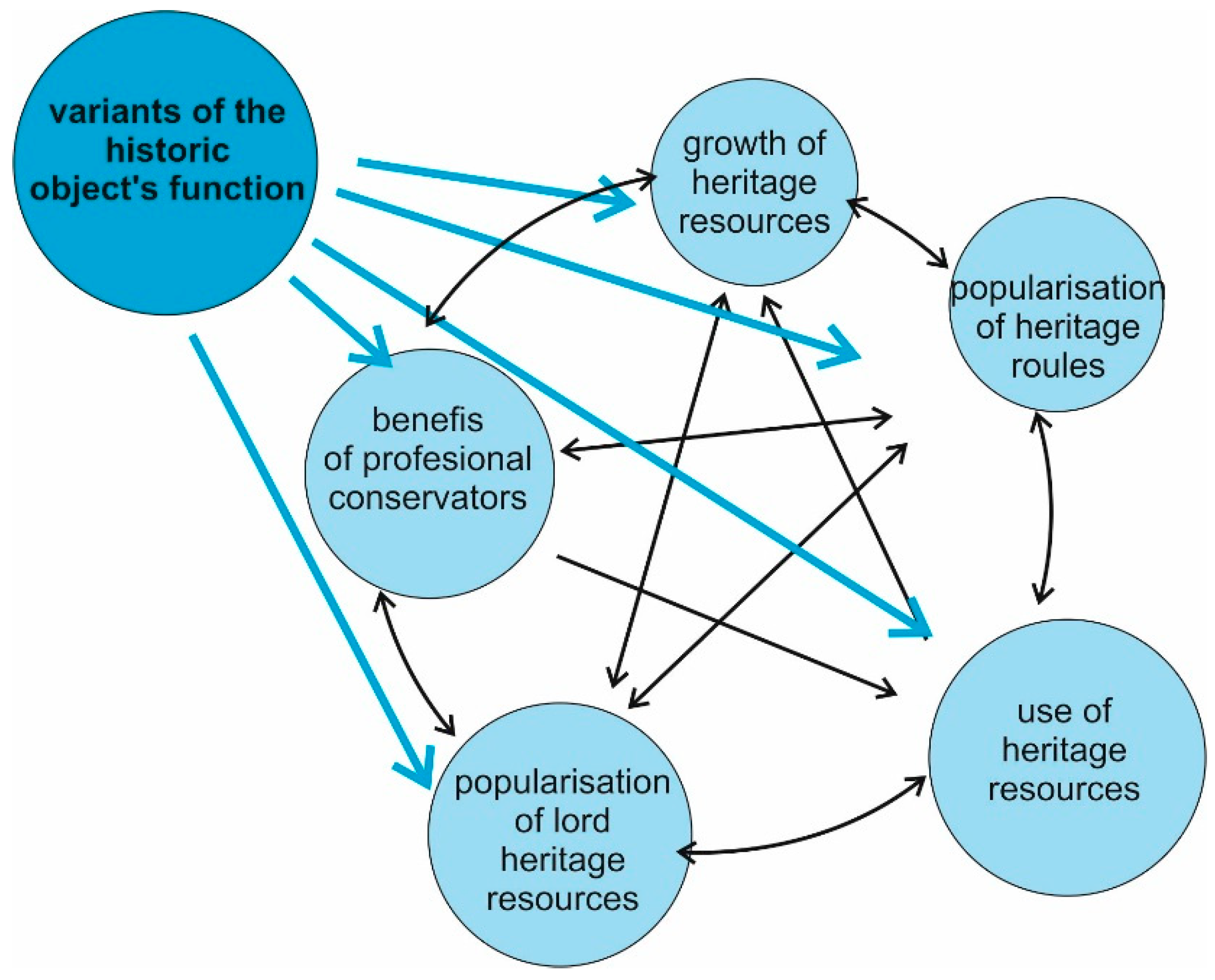
| Type of Partition | Existing State | Current Requirements in Poland | Requirements for NZEB Buildings in Poland (from 2021) | Requirements for Passive Buildings | The Difference of the Existing State from the Current Requirements in Poland |
|---|---|---|---|---|---|
| External walls | 0.55 | 0.23 | 0.20 | 0.15 | 239% |
| Roofs and floors | 0.56 | 0.18 | 0.15 | 0.15 | 311% |
| Floor on the ground | 1.75 | 0.30 | 0.30 | 0.15 | 583% |
| Windows | 1.60 | 1.10 | 0.90 | 0.80 | 145% |
| No. | Designation of the Building | Criterion F1 F1/P1 (Coefficient U (W/m2rok])) |
|---|---|---|
| 1 | Reference variant—Hostel (existing state) | 0.55 |
| 2 | Variant 1—Five-star hotel | 0–0.15—class A 0.16–0.22—class B U ≥ 0.23—class C |
| 3 | Variant 2—Zakopane Art Gallery | 0–0.15—class A 0.16–0.22—class B U ≥ 0.23—class C |
| 4 | Variant 3—Conference and training centre | 0–0.15—class A 0.16–0.22—class B U ≥ 0.23—class C |
| No. | Designation of the Building | Criterion F1 F1/P2 (EK, kWh/m2rok) |
|---|---|---|
| 1 | Reference variant—Hostel (existing state) | 244.79 |
| 2 | Variant 1—Five-star hotel | EK reduction: >60%—class A >50%—class B >40%—class C |
| 3 | Variant 2—Zakopane Art Gallery | EK reduction: >60%—class A >50%—class B >40%—class C |
| 4 | Variant 3—Conference and training centre | EK reduction: >60%—class A >50%—class B >40%—class C |
| No. | Designation of the Building | Criterion F2 F2/P1 n50, 1/h |
|---|---|---|
| 1 | Reference variant—Hostel (existing state) | For negative pressure n50 = 10.09 For overpressure n50 = 8.83 |
| 2 | Variant 1—Five-star hotel | 0–0.6—class A 0.6–1.5—class B n50 ≥ 1.5—class C |
| 3 | Variant 2—Zakopane Art Gallery | 0–0.6—class A 0.6–1.5—class B n50 ≥ 1.5—class C |
| 4 | Variant 3—Conference and training centre | 0–0.6—class A 0.6–1.5—class B n50 ≥ 1.5—class C |
| Room Category | Coefficients: | |
|---|---|---|
| PMV (–) | PPD (%) | |
| A | −0.2 < PMV < +0.2 | <6 |
| B | −0.5 < PMV < +0.5 | <10 |
| C | −0.7 < PMV < +0.7 | <15 |
| Type of Sensor | Measurement Range | Scale | Accuracy |
|---|---|---|---|
| Temperature sensors | −20 °C + 50 °C (wet thermometer 0 °C + 5 °C) | 0.01°C | ± 0.4 °C |
| Humidity sensors | 0–100% | 0.1 RH (relative humidity) | ± 2% RH (relative humidity) |
| Air velocity sensors | 0–5 m/s | 0.01 m/s | for 0–1 m/s: ± 0.05 + 0.05 × Va m/s for 1–5 m/s: ± 5 % |
| No. | Designation of the Building | Criterion F3 F3/P1(PMV (–)) |
|---|---|---|
| 1 | Reference variant—Hostel (existing state) | −0.7—0.25 |
| 2 | Variant 1—Five-star hotel | −0.2–0.2—class A −0.5–0.5—class B −0.5 > PMV > 0.5—class C |
| 3 | Variant 2—Zakopane Art Gallery | −0.2–0.2—class A −0.5–0.5—class B −0.5 > PMV > 0.5—class C |
| 4 | Variant 3—Conference and training centre | −0.2–0.2—class A −0.5–0.5—class B −0.5 > PMV > 0.5—class C |
| No. | Designation of the Building | Criterion F3 F3/P2 | |
|---|---|---|---|
| 1 | Reference variant—Hostel (existing state) | ||
| 2 | Variant 1—Five-star hotel | Vibration not perceptible | 0–0.79—class A |
| Vibration perceptible but not harmful | 0.8–1.19—class B | ||
| Harmful vibration | >1.2—class C | ||
| 3 | Variant 2—Zakopane Art Gallery | Vibration not perceptible | 0–1.19—class A |
| Vibration perceptible but not harmful | 1.2–3.99—class B | ||
| Harmful vibration | >4.0—class C | ||
| 4 | Variant 3—Conference and training centre-conference rooms | Vibration not perceptible | 0–1.09—class A |
| Vibration perceptible but not harmful | 1.1–1.99—class B | ||
| Harmful vibration | >2.0—class C | ||
| 5 | Variant 3—Conference and training centre—hotel rooms | Vibration not perceptible | 0–0.89—class A |
| Vibration perceptible but not harmful | 0.9–1.29—class B | ||
| Harmful vibration | >1.3—class C | ||
| Room Type | Maximal Value of Equivalent Sound Level [29] | Maximal Value of Standardized Equivalent Sound Level [32] |
|---|---|---|
| LAeq, dB | LAeq,nT, dB | |
| Hotel room | 30 * | 25 |
| Conference room | 35 | 35 |
| Restaurant kitchen | 55 | - |
| Restaurant/bar | 45 | 45 |
| Toilets | 45 | 40 |
| Reception | 40 | 40 |
| Office | 35 | 35 |
| Spa | 35 | - |
| Swimming pool | 45 | 50 |
| Cloakroom | 45 | - |
| Room # | Zone | Room Type | Measured Equivalent Sound Level LAeq, dB | Measured Equivalent Sound Level in Control Point during Room Measurement LAeq,ext, dB | Maximum Permitted Sound Level (EU), dB | Maximum Permitted Sound Level (PL), dB | Maximum Noise Level with a Fast Time Constant LAFmax, dB |
|---|---|---|---|---|---|---|---|
| 1.1 | 1 | Kitchen | 31.4 | 58.9 | 55 (met) | - (met) | 40.6 |
| 1.2 | 1 | Dining room | 41.0 | 58.2 | 45 (met) | 45 (met) | 52.2 |
| 1.3 | 1 | Wardrobe | 34.2 | 58.3 | - (met) | - (met) | 46.0 |
| 1.4 | 1 | Room | 30.7 | 58.1 | 30 (not met) | 25 (not met) | 40.5 |
| 1.5 | 1 | Room | 25.1 | 57.5 | 30 (met) | 25 (not met) | 33.3 |
| 2.3 | 1 | Room | 27.9 | 59.3 | 30 (met) | 25 (not met) | 37.2 |
| 2.4 | 1 | Room | 28.2 | 59.1 | 30 (met) | 25 (not met) | 39.2 |
| 2.6 | 1 | Room | 21.5 | 60 | 30 (met) | 25 (met) | 30.8 |
| 2.7 | 1 | Room | 22.6 | 59.1 | 30 (met) | 25 (met) | 34.3 |
| 3.11 | 1 | Bathroom | 33.8 | 59.9 | 45 (met) | 40 (met) | 43.5 |
| 3.4 | 1 | Bathroom | 32.9 | 60.3 | 45 (met) | 40 (met) | 43.9 |
| 3.5 | 1 | Room | 32.4 | 61.1 | 30 (not met) | 25 (not met) | 43.7 |
| 3.6 | 1 | Room | 38.5 | 62 | 30 (not met) | 25 (not met) | 46.6 |
| 3.7 | 1 | Room | 36.8 | 60.6 | 30 (not met) | 25 (not met) | 48.3 |
| 3.8 | 1 | Room | 40.5 | 60.3 | 30 (not met) | 25 (not met) | 50.3 |
| 3.9 | 1 | Room | 33.5 | 59.6 | 30 (not met) | 25 (not met) | 42.4 |
| 2.2 | 2 | Reception | 23.7 | 58.4 | 40 (met) | 40 (met) | 35.2 |
| 2.5 | 2 | Corridor | 22.4 | 59.5 | - (met) | - (met) | 31.3 |
| 3.1 | 2 | Corridor | 23.2 | 61.5 | - (met) | - (met) | 31.4 |
| 1.13 | 3 | Wardrobe | 22.3 | 56.7 | - (met) | - (met) | 34.0 |
| 1.14 | 3 | Laundry | 24.6 | 57.8 | - (met) | - (met) | 35.8 |
| 2.12 | 3 | Room | 21.0 | 59.2 | 30 (met) | 25 (met) | 31.4 |
| 2.17 | 3 | Room | 25.1 | 60 | 30 (met) | 25 (not met) | 34.8 |
| 3.14 | 3 | Room | 26.4 | 60.5 | 30 (met) | 25 (not met) | 38.3 |
| 3.15 | 3 | Room | 24.1 | 60.6 | 30 (met) | 25 (met) | 32.3 |
| 3.17 | 3 | Room | 25.3 | 59 | 30 (met) | 25 (not met) | 37.0 |
| 4.4 | 3 | Room | 26.9 | 59.4 | 30 (met) | 25 (not met) | 38.0 |
| 4.8 | 3 | Room | 30.6 | 59.6 | 30 (not met) | 25 (not met) | 38.8 |
| Building Type | LA,eq, dB | LAFmax, dB | Percentage of Dissatisfied People | Class | |
|---|---|---|---|---|---|
| museum, exhibition hall | 30 | 37 | 10% | A | |
| 35 | 42 | 20% | B | ||
| 40 | 46 | 30% | C | ||
| five-star hotel rooms | 20 | 27 | 10% | A | |
| 25 | 32 | 20% | B | ||
| 30 | 36 | 30% | C | ||
| conference centre | conference rooms | 30 | 37 | 10% | A |
| 35 | 42 | 20% | B | ||
| 40 | 46 | 30% | C | ||
| hotel rooms | 20 | 27 | 10% | A | |
| 25 | 32 | 20% | B | ||
| 30 | 36 | 30% | C | ||
| No. | Type of Building | EP H+W Indicator for Heating, Ventilation and Domestic Hot Water [kWh/(m2rok)] | |
|---|---|---|---|
| Current Requirements | For NZEB Buildings in Poland | ||
| 1 | Single-family building | 95 | 70 |
| 2 | Multi-family building | 85 | 65 |
| 3 | Healthcare building | 290 | 190 |
| 4 | Public building | 60 | 45 |
| 5 | Commercial building, warehouse | 90 | 70 |
| No. | Designation of the Building | Criterion F4 F4/P1 EPH+W, kWh/m2rok |
|---|---|---|
| 1 | Reference variant—Hostel (existing state) | 86.24 |
| 2 | Variant 1—Five-star hotel | 0–20—class A 21–59—class B EP ≥ 60—class C |
| 3 | varIant 2—Zakopane Art Gallery | 0–20—class A 21–59—class B EP ≥ 60—class C |
| 4 | Variant 3—Conference and training centre—hotel rooms | 0–20—class A 21–59—class B EP ≥ 60—class C |
| No. | Designation of the Building | Criterion F5 F5/P1 PI (Profitability Index) |
|---|---|---|
| 1 | Reference variant—Hostel (existing state) | 1.03 |
| 2 | Variant 1—Five-star hotel | 1.06 |
| 3 | Variant 2—Zakopane Art Gallery | 0.05 |
| 4 | Variant 3—Conference and training centre—hotel rooms | 0.56 |
| The Criterion for Social Benefits | |
|---|---|
| 1 | Sense of security |
| 2 | Integration opportunities |
| 3 | Strengthening the sense of local identity |
| 4 | Social participation in managing heritage resources |
| 5 | Solving the pressing needs of the local community |
| The Criterion for Benefits from the Protection of Cultural Heritage | |
|---|---|
| 1 | Increase in heritage resources |
| 2 | Promoting the value of heritage |
| 3 | Use of heritage resources |
| 4 | Popularisation of local heritage resources |
| 5 | Benefits of a professional environment of conservators |
| Criteria/ Sub-criterion No | Variant No. | |||
|---|---|---|---|---|
| Reference Variant—Hostel (Existing State) | Variant 1— Five-star Hotel | Variant 2— Zakopane Art Gallery | Variant 3— Conference and Training Centre | |
| Criterion F1 F1/P1 (coefficient U (W/m2rok)) | 0.55 | 0–0.15—class A 0.16–0.22—class B U ≥ 0.23—class C | 0–0.15—class A 0.16–0.22—class B U ≥ 0.23—class C | 0–0.15—class A 0.16–0.22—class B U ≥ 0.23—class C |
| Criterion F1 F1/P2 (EK, kWh/(m2rok)) | 244.79 | EK reduction: >60%—class A >50%—class B >40%—class C | EK reduction: >60%—class A >50%—class B >40%—class C | EK reduction: >60%—class A >50%—class B >40%—class C |
| Criterion F2 F2/P1 n50, (1/h) | For negative pressure n50 = 10.09 For overpressure n50 = 8.83 | 0–0.6—class A 0.6–1.5—class B n50 ≥ 1.5—class C | 0–0.6—class A 0.6–1.5—class B n50 ≥ 1.5—class C | 0–0.6—class A 0.6–1.5—class B n50 ≥ 1.5—class C |
| Criterion F3 F3/P1 (PMV (-)) | −0.7/0.25 | −0.2–0.2—class A −0.5–0.5—class B −0.5>PMV> 0.5—class C | –0.2–0.2—class A –0.5–0.5—class B –0.5 > PMV > 0.5—class C | –0.2–0.2—class A –0.5–0.5—class B –0.5 > PMV > 0.5—class C |
| Criterion F3 F3/P2 (Frequency (Hz)) | 0–0.79—class A 0.8–1.19—class B >1.2—class C | 0–1.19—class A 1.2–3.99—class B >4.0—class C | 0–1.09—class A * 1.1–1.99—class B * >2.0—class C * | |
| Criterion F3 F3/P3 LA,eq/LAF,max (dB) | 40.5/50.3 | ≤20/27—class A ≤25/32—class B ≤30/36—class C | ≤30/37—class A ≤35/42—class B ≤40/46—class C | ≤20/27—class A * ≤25/32—class B * ≤30/36—class C * |
| Criterion F4 F4/P1 EPH+W (kWh/m2rok) | 86.24 | 0–20—class A 21–59—class B EP ≥ 60—class C | 0–20—class A 21–59—class B EP ≥ 60—class C | 0–20—class A 21–59—class B EP ≥ 60—class C |
| Criterion F5 F5/P1 PI (Profitability Index) | 1.03 | 1.06 | 0.05 | 0.56 |
| Criterion F6 F6/P1 (%) | 0.13 | 0.18 | 0.42 | 0.28 |
| Criterion F7 F7/P1 (%) | 0.16 | 0.22 | 0.38 | 0.23 |
© 2019 by the authors. Licensee MDPI, Basel, Switzerland. This article is an open access article distributed under the terms and conditions of the Creative Commons Attribution (CC BY) license (http://creativecommons.org/licenses/by/4.0/).
Share and Cite
Fedorczak-Cisak, M.; Kowalska-Koczwara, A.; Nering, K.; Pachla, F.; Radziszewska-Zielina, E.; Śladowski, G.; Tatara, T.; Ziarko, B. Evaluation of the Criteria for Selecting Proposed Variants of Utility Functions in the Adaptation of Historic Regional Architecture. Sustainability 2019, 11, 1094. https://doi.org/10.3390/su11041094
Fedorczak-Cisak M, Kowalska-Koczwara A, Nering K, Pachla F, Radziszewska-Zielina E, Śladowski G, Tatara T, Ziarko B. Evaluation of the Criteria for Selecting Proposed Variants of Utility Functions in the Adaptation of Historic Regional Architecture. Sustainability. 2019; 11(4):1094. https://doi.org/10.3390/su11041094
Chicago/Turabian StyleFedorczak-Cisak, Małgorzata, Alicja Kowalska-Koczwara, Krzysztof Nering, Filip Pachla, Elżbieta Radziszewska-Zielina, Grzegorz Śladowski, Tadeusz Tatara, and Bartłomiej Ziarko. 2019. "Evaluation of the Criteria for Selecting Proposed Variants of Utility Functions in the Adaptation of Historic Regional Architecture" Sustainability 11, no. 4: 1094. https://doi.org/10.3390/su11041094
APA StyleFedorczak-Cisak, M., Kowalska-Koczwara, A., Nering, K., Pachla, F., Radziszewska-Zielina, E., Śladowski, G., Tatara, T., & Ziarko, B. (2019). Evaluation of the Criteria for Selecting Proposed Variants of Utility Functions in the Adaptation of Historic Regional Architecture. Sustainability, 11(4), 1094. https://doi.org/10.3390/su11041094







